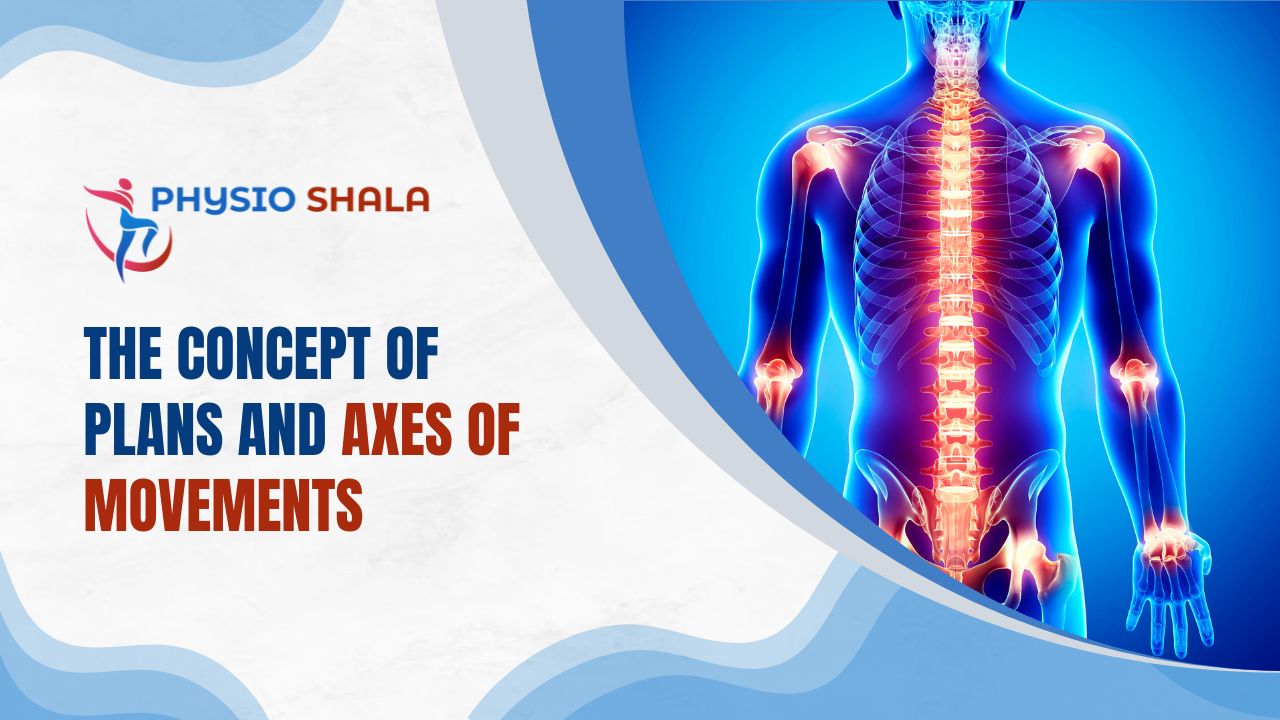Planes and axes are imaginary surfaces and lines that are used to describe the movements of the human body. Any movement at joints is described using these terminologies and are universal so that everyone understands the same thing when a movement is described using axis and plane. The anatomical position (shown below) of the human body is the reference for all movements.
Planes of Movements
Planes are defined as imaginary flat surfaces in which the movements take place, i.e. movements are parallel to a specific plane. A plane is perpendicular to the axis passing through it, and it passes through the body.
There 3 cardinal planes of movement:
- Frontal plane (Coronal plane)
- Sagittal plane (A-P plane)
- Transverse plane (Horizontal plane)
Frontal Plane or Coronal Plane
- This plane divides the body into two equal front and back parts
- It passes through the coronal suture of the skull hence the name
- Movement occurs in the X-Y plane
- Movement in this plane occurs about a sagittal axis or A-P axis
- Possible Movements- abduction and adduction
Sagittal Plane
- Sagittal plane divides the body into equal right and left parts
- The plane passes through the sagittal suture of the skull
- Movements occur in the Y-Z plane
- Movements in this plane occurs about the frontal or coronal axis
- Possible movements- flexion and extension
Sagittal plane can be- Midsagittal/ median plane or Parasagittal. As the name suggests the midsagittal plane divides the body through midline structures like the navel or spine, whereas parasagittal planes are parallel to the median plane
Transverse Plane
- transverse plane divides the body into equal upper and lower parts
- this plane is parallel to the transverse suture of the skull
- movements occurring in this plane are in the X-Z plane
- movements in this plane occurs about the vertical axis
- Possible Movements- lateral and medial rotations
Axes of Movements
Axis is an imaginary straight line about which a movement takes place and it is at a right angle to a plane. Axes pass through the joints of the body. Again, axes are also defined with reference to the anatomical position of the human body. Thus, movement at a joint occurs about an axis and in a plane.
There are three axes of movement:
- Frontal Axis
- Sagittal or A-P axis
- Vertical Axis
Frontal/ Transverse axis– This axis is horizontal and passes from left to right through the body. It is parallel to the transverse plane or transverse suture of the skull. Movement about a frontal axis occurs in the sagittal plane.
Sagittal Axis– this line passes horizontally through the body and runs anterior to posterior. It is parallel to the sagittal suture of the skull. Movements about this axis occur in the frontal plane.
Vertical Axis– as per the name this axis runs vertically from top to bottom through the body. It is parallel to the line of gravity passing through the body. Movements about the vertical axis occur in the horizontal or transverse plane.
Movements
Extension Movements
The Extension at a joint occurs when the angle between two adjacent body parts increases and the ventral surfaces of those parts move away. Extension movement occurs in the sagittal plane about the frontal axis.
Flexion
It is opposite to extension, here the ventral surfaces of two adjacent body parts come closer towards each other and the angle between those parts reduces. Flexion also occurs about a frontal axis in the sagittal plane.
Except- Flexion and Extension of the thumb occur in the frontal plane and sagittal axis.
Movement in the sagittal plane about the frontal axis
Abduction
This movement occurs in the frontal plane about the sagittal axis. In abduction, a body part moves away from the imaginary center line passing through the body.
Adduction Movements
This movement is opposite to abduction as the body part is moved toward the imaginary center line or across that line towards the other side.
Examples of abduction and adduction movements are given in the figure below.
Movement in the frontal plane about the sagittal axis
Rotation Movements
Rotation movement occurs in the transverse plane and about a vertical axis. It is a twisting movement. Shoulder and hip that are ball and socket joint permit rotation called medial and lateral rotation (or internal and external rotation respectively).
Rotation movements also occur in the spine. The atlantoaxial joint between C1 and C2 vertebrae is a pivot joint and thus allows rotation of the neck to either side. Movement in the transverse (horizontal) plane about the vertical axis.
References
https://en.wikipedia.org/wiki/Anatomical_plane
https://en.wikipedia.org/wiki/Sagittal_plane

